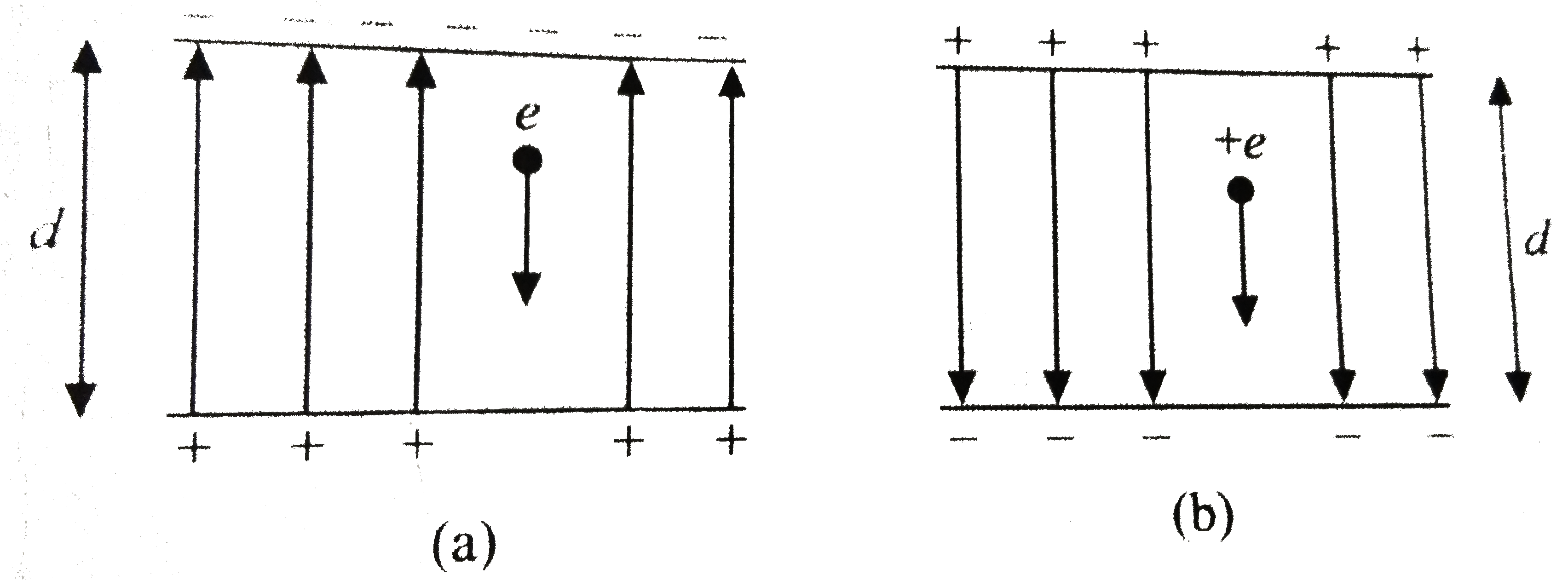An electron falls from rest through a vertical distance h in a uniform and vertically upwards directed electric field E. The direction of electric field is now reversed , keeping its magnitude the same. A proton is allowed to fall from rest in it through the same vertical distance h. The time of fall of the electron, in comparison to the time of fall proton is
10 times greater
5 times greater
Smaller
Equal
The correct Answer is:C
To solve the problem, we need to analyze the motion of both the electron and the proton under the influence of an electric field. Let's break it down step by step.
Step 1: Understanding the Forces
1. Electron in Upward Electric Field: When the electron falls through a distance h in an upward electric field E, the force acting on it is due to the electric field, which is given by:
Fe=−eE
where e is the charge of the electron (positive value, but the force is negative due to the negative charge of the electron).
2. Proton in Downward Electric Field: When the electric field is reversed, the proton falls through the same distance h. The force acting on the proton is:
Fp=+eE
where e is the charge of the proton.
Step 2: Calculating Acceleration
1. Acceleration of Electron: The acceleration ae of the electron can be calculated using Newton's second law:
ae=Feme=−eEme
where me is the mass of the electron.
2. Acceleration of Proton: Similarly, the acceleration ap of the proton is:
ap=Fpmp=eEmp
where mp is the mass of the proton.
Step 3: Using the Equation of Motion
Since both particles start from rest, we can use the second equation of motion:
h=12at2
to find the time taken for each particle to fall the distance h.
1. Time for Electron:
h=12(−eEme)t2e⟹t2e=2hmeeE⟹te=√2hmeeE
2. Time for Proton:
h=12(eEmp)t2p⟹t2p=2hmpeE⟹tp=√2hmpeE
Step 4: Comparing Times
Now, we can compare the times te and tp:
tetp=√memp
Since the mass of the electron me is much smaller than the mass of the proton mp (approximately me≈9.11×10−31kg and mp≈1.67×10−27kg), we conclude that:
te<tp
Final Conclusion
The time of fall of the electron is less than the time of fall of the proton.
1. Electron in Upward Electric Field: When the electron falls through a distance h in an upward electric field E, the force acting on it is due to the electric field, which is given by:
Fe=−eE
where e is the charge of the electron (positive value, but the force is negative due to the negative charge of the electron).
Fp=+eE
where e is the charge of the proton.
1. Acceleration of Electron: The acceleration ae of the electron can be calculated using Newton's second law:
ae=Feme=−eEme
where me is the mass of the electron.
ap=Fpmp=eEmp
where mp is the mass of the proton.
Since both particles start from rest, we can use the second equation of motion:
h=12at2
to find the time taken for each particle to fall the distance h.
h=12(−eEme)t2e⟹t2e=2hmeeE⟹te=√2hmeeE
h=12(eEmp)t2p⟹t2p=2hmpeE⟹tp=√2hmpeE
Now, we can compare the times te and tp:
tetp=√memp
Since the mass of the electron me is much smaller than the mass of the proton mp (approximately me≈9.11×10−31kg and mp≈1.67×10−27kg), we conclude that:
te<tp
The time of fall of the electron is less than the time of fall of the proton.
Similar Questions
An electron (mass me)falls through a distance d in a uniform electric field of magnitude E.
 ,
,
The direction of the field is reversed keeping its magnitudes unchanged, and a proton(mass mp) falls through the same distance. If the times taken by the electrons and the protons to fall the distance d is telectron and tproton respectively, then the ratio telectron/tproton.
View SolutionAn electron falls through a distance of 1.5 cm in a uniform electric field of magnitude 2.4×104NC−1 [Fig.1.12 (a)]. The direction of the field is reversed keeping its magnitude unchagned and a proton falls through the same distance [Fig. 1.12 (b) ]. Complute the time of fall in each case. Contrast the situation (a) with that of free fall under gravity.

View Solution
Knowledge Check
An electron falls from rest through a vertical distance h in a uniform and vertically upwards directed electric field E. The direction of electric field is now reversed , keeping its magnitude the same. A proton is allowed to fall from rest in it through the same vertical distance h. The time of fall of the electron, in comparison to the time of fall proton is
A10 times greaterB5 times greaterCSmallerDEqualAn electron falls from rest through a vertical distance h in a uniform and vertically upward directed electric field E. the direction of electric field is now reversed, keeping its magnitude the same. A proton is allowed to fall from rest in it through the same vertical distance h.The time of fall of the electron, in comparison to the time of flal of the proton is
A10 times greaterB5 times greaterCsmallerDequalAn electron falls through a small distance in a uniform electric field of magnitude 2×104NC−1. The direction of the field reversed keeping the magnitude unchanged and a proton falls through the same distance. The time of fall will be
ASame in both casesBMore in the case of electronCMore in the case of protonDIndependent of charge
An electron falls through a distance of 1.5cm in a uniform electric field of value 2×104N/C, opposite to direction of fall. Compare the time of fall with 'free fall under gravity'.
View SolutionAn electron and a proton travel through equal distances in the same uniform electric field E. Compare their time of travel. (Neglect gravity)
View SolutionA stone is allowed to fall freely from rest. The ratio of the time taken to fall through the first metre and the second metre distance is
View SolutionA small drop of water falls from rest through a large height h in air, the final velocity is
View SolutionA small drop of water falls from rest through a large height h in air, the final velocity is
View Solution
